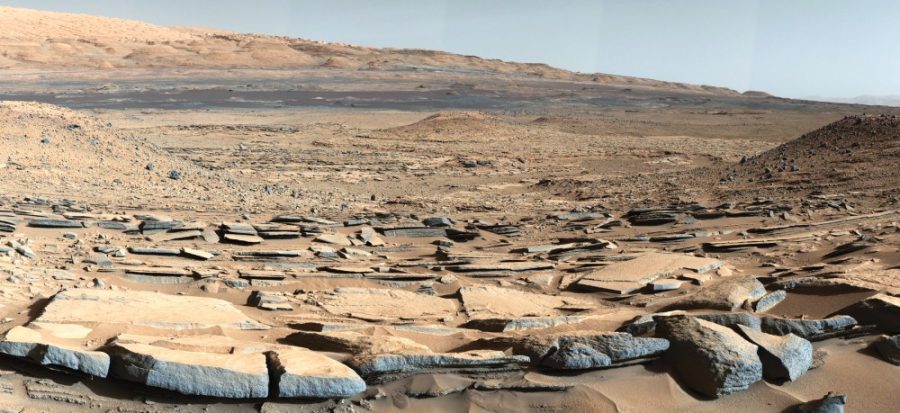Mission to Mars
NASA released a report Thursday outlining the agency’s plans for sending humans to Mars. The report, titled “NASA’s Journey to Mars: Pioneering Next Steps in Space Exploration,” outlines NASA’s three-part plan to land humans on Mars by the 2030s.
The recent announcement of water on Mars combined with the release of the movie “The Martian” has increased public interest in the red planet.
“In the next few decades, NASA will takes steps toward establishing a sustainable human presence beyond Earth,” the report reads.
According to the report, the first part of the plan entails research on the International Space Station and further development of a rocket called the Space Launch System. Research being done on the ISS can help NASA understand the effects that living in space for long periods of time have on humans.
The second part of the plan includes testing in cislunar space, the area of space between the moon and the Earth, according to the report. Here, NASA will run experiments on deep space habitats for humans.
According to the report, the final stage of the plan before landing on Mars involves sending astronauts to orbit Mars and possibly landing on one of Mars’ moons. This phase will allow astronauts to practice a sustained living presence on a planet other than Earth before landing on Mars.
Tiny particles win big prize
The Nobel Prize in Physics was awarded Oct. 6 to Dr. Arthur McDonald, Professor Emeritus at Queen’s University in Kingston, Ontario, for his work on neutrinos. McDonald collaborated and co-won the prize with Takaaki Kajita, a physicist at the University of Tokyo.
Neutrinos are subatomic dark matter particles. It is estimated that dark matter makes up over 95 percent of the matter in the universe. There are three types of neutrinos: electron-type, muon-type and tau-type. McDonald and Kajita’s work demonstrates that neutrinos can alter their matter and convert themselves from one type of neutrino into another. Neutrinos were previously thought to be massless; however, the transformation of neutrinos into different forms entails that neutrinos have mass.
Kajita first found evidence of altering matter in neutrinos in 1998 while working at the Super-Kamiokande detector in Japan, detecting neutrinos being transformed in Earth’s atmosphere. In 2001, McDonald and his researchers found evidence of neutrinos from the sun undergoing a similar transformation while working in the Sudbury Neutrino Observatory.
McDonald said that neutrino research is important to understanding other aspects of scientific research. “By our measurements, we were able to confirm with great accuracy calculations of how the sun burns by fusion processes,” McDonald said in an interview with CBC News.
McDonald said there is still research being done into neutrinos to determine their specific mass and whether there are other types of neutrinos that have not yet been studied.
Stalking pre-historic people
Researchers have been analyzing the DNA of the remains of a hunter-gatherer that were recently found in Ethiopia. According to a paper published in the journal Science on Thursday, researchers have been documenting the genetic code of a man known as Mota, whose remains are believed to be 4,500 years old.
DNA is often difficult to extract from remains found in climates that possess high heat and humidity, such as that of Ethiopia, because it is often not well preserved. According to the paper, Mota’s genetic code was able to be studied because it was preserved in his inner ear bone.
Documenting Mota’s genetic code can help researchers understand the movement patterns of the great migration from Africa to Eurasia that happened 60,000 years ago. The paper suggests that there was a secondary migration from Eurasia back into Africa that took place 3,000 years ago. By comparing Mota’s genome with that of a modern human, researchers were able to estimate how large the secondary migration may have been.
According to the paper, the percentage of Eurasian DNA in Mota’s genome suggests that the secondary migration may have been much larger than previously thought.
“The wave of West Eurasian migration back into the Horn of Africa could have been as much as 30 percent of the population that already lived there,” said Dr. Andrea Manica, senior author of the study from the University of Cambridge’s Department of Zoology in a statement. “And that, to me, is mind-blowing.”
The cause of such a massive intercontinental migration is not yet known. By continuing to study the DNA of ancient remains, researchers will be able to learn more about the causes of early human migrations.
Checks itself before it wrecks itself
The Nobel Prize in Chemistry was awarded to three scientists Oct. 7 for their work in mapping cell repair in DNA. Tomas Lindahl, Paul Modrich and Aziz Sancar were awarded the prize for mapping at a molecular level how cells repair damaged DNA and protect against the loss of genetic information during the process. Their research mapped three different mechanisms by which cells can repair damage to DNA.
Lindahl, a Swedish scientist and cancer researcher, was researching the rapidity of DNA decay rates when he discovered a molecular mechanism that works to counteract the structural collapse of DNA, according to the Royal Swedish Academy of Sciences. This mechanism is called base excision repair.
Mordich, an American biochemistry professor at Duke University, researched the process of how cells correct errors that occur when DNA is replicated at a cellular level. According to the academy, this process is known as mismatch repair and defects in this process are known to cause variants of cancer.
Sancar, a Turkish and American biochemist specializing in DNA repair, contributed to the research by mapping nucleotide excision repair. Nucleotide excision repair is the mechanism that repairs ultraviolet light damage to DNA in cells, according to the academy.
Lindahl, Mordich and Sancar’s research could be influential in researching how the defects in the DNA repair system contribute to different variants of cancer. Their research could also be used to improve future cancer treatments.
Follow Emily Hedges on Twitter.









